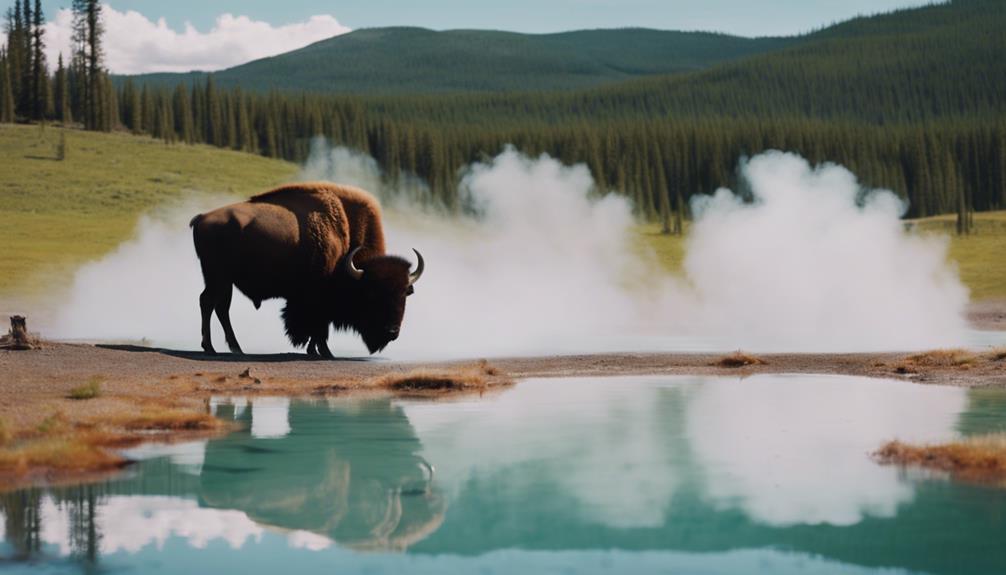Are you ready to discover the fascinating world of heat?
Get ready for an exciting journey as we uncover 10 fun facts about this incredible force.
From the science behind heat to its impact on our daily lives, you’ll be amazed at how much there is to learn.
So grab your curiosity and let’s dive in!
Key Takeaways
- Heat transfer occurs through conduction, convection, and radiation.
- Insulation helps slow down the movement of heat and acts as a barrier between a heat source and an object.
- Extreme temperatures have implications for global warming, heat-related deaths, and the intensification of extreme weather events.
- Heat plays a crucial role in the body’s metabolism, including digestion, muscle movement, and exercise.
The Science Behind Heat
The science behind heat can be explained through the movement of particles. Heat transfer occurs when these particles transfer energy to one another through conduction, convection, or radiation.
In thermodynamics, heat refers to the transfer of thermal energy from a hotter object to a cooler object. It is fascinating to think that everything around us is constantly in motion at the microscopic level, with particles colliding and exchanging energy.
Understanding heat helps us comprehend how our world works and how we can harness it for various purposes. From cooking our food to powering engines, heat plays a crucial role in our daily lives.
So next time you feel warmth on your skin or experience the comforting embrace of a cozy blanket, remember that it’s all because of the amazing science behind heat!
How Heat Travels
So, you’re curious about how heat travels? Well, let me tell you, it’s quite fascinating.
First off, we have heat and conduction – the way heat transfers through direct contact between objects. It’s like a secret handshake between molecules, passing on the energy from one to another.
But that’s not all! There’s also heat and radiation, where energy is carried by electromagnetic waves without any need for physical touch. It’s like a dance of particles in the air, spreading warmth and light wherever they go.
Get ready to dive into the captivating world of heat travel!
Heat and Conduction
Did you know that when you touch a hot stove, the heat is transferred to your hand through conduction? It’s like a secret dance between the stove and your hand, where the stove passes on its fiery energy to you.
But wait, what if there was a way to protect yourself from this scorching sensation? That’s where insulation comes in. Imagine wrapping your hand in a cozy blanket before touching the stove – it would be like creating a barrier between you and the heat.
Insulation works by slowing down the movement of heat, preventing it from easily passing through. So next time you encounter something hot, think about how insulation can save the day by keeping that intense thermal conductivity at bay.
Heat and Radiation
Imagine feeling the warmth of the sun on your face, radiating down from the sky above. It’s a comforting sensation, isn’t it?
Well, did you know that heat is actually transferred through electromagnetic waves? These invisible waves carry thermal energy and are responsible for making things warm.
Here are three fascinating facts about heat and radiation:
- Heat travels in waves: Just like light, heat can travel in the form of electromagnetic waves. These waves move at different frequencies and wavelengths, determining their intensity and temperature.
- Thermal radiation is everywhere: Even when you can’t see it, thermal radiation is all around you. From the glowing embers of a fire to the warmth you feel when standing near a hot object, this type of radiation is constantly being emitted.
- Heat transfer without direct contact: Unlike conduction or convection, which require direct contact or movement of particles, thermal radiation can transfer heat through empty space. This means that even in the vacuum of outer space, objects can still exchange thermal energy through radiation.
So next time you feel that soothing warmth on your skin, remember that it’s not just from the sun but also from these incredible electromagnetic waves carrying thermal energy all around us!
The Hottest Temperature Ever Recorded
Imagine standing in a place where the temperature reaches unimaginable heights, breaking all records. You can feel the scorching heat radiating off the ground, making it hard to breathe.
This extreme temperature is not just an isolated incident; it has implications that extend far beyond our immediate discomfort. It serves as a stark reminder of the impact of global warming on our planet.
Extreme Temperature Records
The hottest temperature ever recorded on Earth occurred in Death Valley, California. It reached a scorching 134 degrees Fahrenheit on July 10, 1913.
Can you imagine the extreme heatwaves that must have engulfed the region that day? The sheer intensity of the sun’s rays beating down can be unfathomable.
Heat-related deaths are unfortunately a consequence of such extreme temperatures. However, we have come a long way in understanding how to protect ourselves from these dangers. Today, we have advanced technologies and knowledge to help us cope with the relentless heat.
From air conditioning systems to smart clothing materials that regulate body temperature, we are constantly innovating to ensure our safety and comfort during even the most blistering heatwaves.
Global Warming Implications
You can’t deny the impact of global warming on our planet’s ecosystems. The rising temperatures and sea levels are causing significant changes to our environment. Here are three eye-opening facts about the consequences of global warming:
- Melting ice caps: As temperatures rise, glaciers and ice sheets around the world are melting at an alarming rate. This leads to increased sea levels, which threaten coastal communities and wildlife habitats.
- Extreme weather events: Global warming intensifies weather patterns, resulting in more frequent and severe hurricanes, droughts, wildfires, and heatwaves. These events endanger lives, destroy homes, and disrupt ecosystems.
- Loss of biodiversity: Rising temperatures disrupt natural habitats, leading to the extinction or migration of various plant and animal species. This loss of biodiversity has far-reaching consequences for ecosystem stability and food webs.
It is crucial that we acknowledge the impact of global warming on our planet’s ecosystems if we wish to protect our environment for future generations. Let us come together as a community to address this pressing issue and create a sustainable future for all living beings on Earth.
Heat and Energy
Heat is the result of energy transfer. It’s what makes your world warm and cozy, filling it with comfort and belonging.
But did you know that heat plays a vital role in the field of thermodynamics? Thermodynamics is all about understanding how heat moves and transforms energy. It’s like a dance, where heat and energy exchange partners, creating a symphony of motion.
And when it comes to renewable energy, heat is at the forefront. Think about solar power for instance – harnessing the sun’s heat to generate electricity. Or geothermal energy, tapping into Earth’s natural warmth deep below the surface.
Heat has the power to change our lives, pushing us towards a future fueled by sustainable sources of energy. So embrace the warmth, let it ignite your imagination, and join this incredible journey towards a greener tomorrow!
Heat and the Human Body
Now that you know how heat is related to energy, let’s explore how it affects your amazing body. Heat plays a crucial role in your metabolism, which is like the engine that keeps everything running smoothly inside you. When your body creates heat through processes like digestion and muscle movement, it speeds up your metabolism, helping you burn calories and maintain a healthy weight.
But did you know that exercise also generates heat? As you move and challenge your muscles, they produce heat to keep you going. This is why you might feel warm or even break a sweat during a workout.
So next time you’re at the gym or out for a run, remember that the heat generated by your body is fueling your progress and bringing you one step closer to achieving your fitness goals.
- Heat boosts your metabolism.
- Digestion and muscle movement create heat in your body.
- Exercise increases the production of heat.
- The warmth and sweat experienced during workouts are signs of increased heat generation within the body.
Embrace the power of heat as it propels you towards becoming the best version of yourself!
Heat-Related Illnesses
Are you ready to dive into the important topic of preventing heat-related illnesses and recognizing their symptoms?
It’s crucial to take proactive measures to protect yourself from the dangers of excessive heat. By understanding how to prevent heat-related illnesses and being able to recognize the symptoms, you can ensure your well-being during hot weather conditions.
So let’s explore these key points together and equip ourselves with knowledge that will keep us safe and healthy.
Preventing Heat-Related Illnesses
To stay safe and avoid heat-related illnesses, make sure you’re hydrating regularly and wearing lightweight, breathable clothing. Preventing dehydration is crucial during hot weather, as it helps regulate your body temperature and keeps you feeling refreshed. Drink plenty of water throughout the day and avoid excessive caffeine or alcohol consumption, as they can contribute to dehydration. Staying cool is also essential in preventing heat-related illnesses. Find shade whenever possible, use fans or air conditioning to circulate air, and take frequent breaks in cool areas. Here’s a fun fact table to keep you engaged:
| Fun Heat Fact | Did You Know? |
|---|---|
| 1. The hottest temperature ever recorded on Earth was 134 degrees Fahrenheit (56.7 degrees Celsius) in Death Valley, California. | Stay hydrated to beat the heat! |
| 2. The sun is actually white; its perceived color changes due to Earth’s atmosphere scattering light differently at different times of the day. | Keep yourself cool with light-colored clothing! |
| 3. Antarctica holds the record for the coldest temperature ever recorded on land: a bone-chilling -128 degrees Fahrenheit (-89 degrees Celsius). | Hydrate even in cold climates to avoid dehydration! |
Recognizing Heat-Related Symptoms
Make sure you pay attention to your body and recognize any symptoms of heat-related illnesses, such as dizziness, fatigue, or excessive sweating. Your body is a remarkable machine, constantly sending you signals and clues about its well-being. It’s important to listen and respond accordingly.
When it comes to heatstroke prevention, being aware of the warning signs is crucial. If you start feeling dizzy or lightheaded, it might be a sign that your body is struggling to regulate its temperature. Fatigue can also be a symptom indicating that you are overheating. Excessive sweating may seem like a normal response to the heat, but if it becomes excessive or stops suddenly, it could signal trouble.
The Role of Heat in Cooking
Heat plays a crucial role in cooking. It helps to transform raw ingredients into delicious meals. Whether you’re frying up a crispy batch of french fries or simmering a hearty stew, temperature control is key.
Picture yourself in the kitchen, skillfully adjusting the heat on your stove to create culinary masterpieces that bring people together. As you sauté onions and garlic, their aromas fill the air, drawing everyone into the heart of your home. The sizzle of meat hitting a hot pan creates an enticing melody that beckons hungry souls to gather around.
With each controlled burst of heat, flavors meld and textures develop, creating symphonies of taste that satisfy both stomachs and hearts. So go forth, embrace the power of heat in your kitchen, and let it weave its magic as you create delectable dishes that foster connection and belonging.
Heat and Climate Change
As temperatures rise due to climate change, the frequency and intensity of heatwaves will also increase.
Picture this: you’re walking through a bustling city on a scorching summer day. The sun beats down on your skin, making you feel like you’re in an oven. Sweat drips down your forehead as you search for shade, desperately trying to escape the sweltering heat.
But it’s not just discomfort you should worry about. Heatwaves caused by climate change can have serious impacts on your health. Prolonged exposure to extreme heat can lead to dehydration, heat exhaustion, and even heat stroke.
It’s important to stay hydrated, seek air-conditioned spaces when possible, and take care of yourself during these increasingly frequent and intense heatwaves brought on by our changing climate.
Stay cool and stay safe!
Heat in the Animal Kingdom
Imagine yourself in the animal kingdom, surrounded by creatures who have adapted to thrive in diverse climates and survive extreme temperatures. In this fascinating realm, heat plays a crucial role in the survival strategies of different animals.
Here are some interesting ways that animals utilize heat:
- Heat and Camouflage: Some animals use their ability to regulate body temperature to blend into their surroundings. By matching their body temperature with the environment, they become virtually invisible.
- Heat and Hibernation: In cold climates, certain animals enter a state of hibernation during winter months. They lower their body temperature and slow down their metabolism to conserve energy until warmer days arrive.
- Heat as Communication: Animals like birds use heat to communicate with each other through courtship rituals. For instance, male birds may puff up their feathers to appear larger and more attractive to potential mates.
- Heat for Defense: Some reptiles can tolerate scorching temperatures due to specialized skin that reflects sunlight. This adaptation helps them avoid overheating and protects against predators.
- Heat as a Weapon: Venomous snakes produce venom using specialized glands that require high temperatures. This deadly concoction aids in capturing prey or defending themselves from threats.
In the animal kingdom, heat is not just an environmental factor but also a powerful tool for survival and adaptation.
Fun Heat Experiments to Try at Home
You can try out these exciting experiments at home to explore the effects of temperature and heat on different objects.
Heat isn’t just about making things hot; it can also create fascinating art and music.
To start, grab some crayons and a canvas. Place the canvas outside in direct sunlight and arrange the crayons on top. Watch as the heat melts the crayons, creating beautiful abstract designs.
If you’re interested in music, grab some glasses filled with varying amounts of water. Gently tap each glass with a spoon to produce different pitches. Now, slowly add warm or cold water to see how it affects the pitch of each glass.
You’ll be amazed at how heat can transform ordinary objects into extraordinary works of art and music!
Frequently Asked Questions
How Does Heat Affect the Growth of Plants?
Heat’s impact on plant development is significant. It influences the growth and productivity of plants. Understanding how heat affects them can help you create an environment where they thrive, fostering a sense of belonging in your garden.
Can Heat Cause Changes in the Chemical Composition of Materials?
Heat can definitely cause changes in the chemical composition of materials. When exposed to high temperatures, materials undergo heat-induced chemical reactions that alter their structure and properties. It’s fascinating how heat transforms things!
What Are Some Ways to Prevent Heat Loss in Buildings?
To prevent heat loss in buildings, you can insulate them effectively. Importance of insulation is undeniable as it keeps your space cozy and reduces energy consumption. So, don’t forget to insulate properly!
Is It Possible to Convert Heat Energy Into Other Forms of Energy?
Yes, it is possible to convert heat energy into other forms of energy. Through heat conversion, you can harness the power of heat and transform it into useful work or electricity with efficiency analysis. Join the exciting world of energy transformation!
How Does Heat Play a Role in the Formation of Weather Patterns?
Heat plays a crucial role in the formation of weather patterns. It influences climate change and affects atmospheric circulation, shaping the world around you. Discover how heat’s impact creates the mesmerizing dance of clouds, wind, and rain. Be part of this captivating phenomenon.
Conclusion
So there you have it, my friend! You’ve just delved into the fascinating world of heat and discovered 10 fun facts that will leave you feeling enlightened.
From the science behind how heat travels to its role in cooking and climate change, heat has a profound impact on our lives.
And let’s not forget about its effect on the human body and the animal kingdom!
So why not try some fun heat experiments at home and continue exploring this incredible force?
The possibilities are endless, so go out there and embrace the heat!





